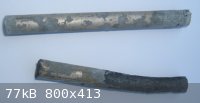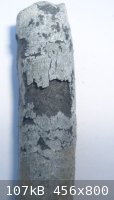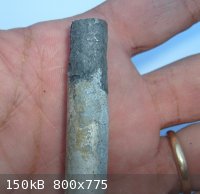a_bab
Hazard to Others
  
Posts: 458
Registered: 15-9-2002
Member Is Offline
Mood: Angry !!!!!111111...2?!
|
|
Magnesium–zinc intermetallic compound
In my neverending hunt for interesting things, I stumbled upon an old plastic box with some magnesium rods (old chemistry lab). There was a bit of
zinc powder on the bottom of the box too.
To my amazement, the ends of the rods that have been in direct contact with the zinc powder looked "inflated" and corroded. It looked kind of "tin
pest", and I knew it must be a reaction between the two metals. The two must have been in contact for at least 15 years I'd say.
The intermetallic compound had enough magnesium in it to take fire almost like a magnesium chip, but quite not so, as it burned with no flame, kind of
a fuse. It took quite a few whhacks with the hammer to flake off (it was tough, but it could be easily pulverized, just like rust).
Turned out I was right: http://cat.inist.fr/?aModele=afficheN&cpsidt=17854515
I attached some pics.
  
|
|
|
JohnWW
International Hazard
    
Posts: 2849
Registered: 27-7-2004
Location: New Zealand
Member Is Offline
Mood: No Mood
|
|
Two fairly electropositive dissimilar metals in contact with each other in the presence of water, or at least moist air, would result in electrolytic
corrosion, forming the oxide of the more electropositive metal. I think that this, MgO, probably hydrous, is what was formed on the Mg rods in contact
with Zn powder, and further contact with air would result in formation of MgCO3. This is also why Mg and Al and Zn are used as "sacrificial anodes",
in electrical contact with mild steel or cast iron articles exposed to water, such as pipes and ships' hulls, to protect them from rusting through
formation of permeable Fe2O3 or FeO(OH); it is also part of the reason for plating mild steel and cast iron articles with Zn or a molten Al-Zn mixture
("galvalume"), along with the impermeability of Zn and Al to water and air, and the ZnO and Al2O3 initially formed on their surfaces likewise being
impermeable.
[Edited on 25-7-09 by JohnWW]
|
|
|
a_bab
Hazard to Others
  
Posts: 458
Registered: 15-9-2002
Member Is Offline
Mood: Angry !!!!!111111...2?!
|
|
I doubt, as the product was very tough and black (as seen in the pics). Moreover, it had a crystaline aspect. And it burned in air. MgCO3/MgO are both
white (visible on the non "corroded" side of the rod)
|
|
|
kclo4
National Hazard
   
Posts: 916
Registered: 11-12-2004
Location:
Member Is Offline
Mood: No Mood
|
|
Well, since it sounds like you have both Mg and Zn, can't you test this by heating them together or something in an inert atmosphere?
|
|
|
turd
National Hazard
   
Posts: 800
Registered: 5-3-2006
Member Is Offline
Mood: No Mood
|
|
Sorry a_bab, chemistry doesn't work that way. Just because a compound exists doesn't mean that it will form under ordinary conditions. And the speed
of diffusion of solids at room temperature is typically not very fast. So unless you get some analysis (ideally powder XRD) it's highly doubtful that
you have a Mg/Zn alloy. Your pictures look like corroded metal, FWIW.
|
|
|
a_bab
Hazard to Others
  
Posts: 458
Registered: 15-9-2002
Member Is Offline
Mood: Angry !!!!!111111...2?!
|
|
Well, I was thinking about the mercury alloys; they can form at room temperature. If you ever played with that, a thin Sn foil will instantly alloy
with Hg (good method to harvest Hg dropplets).
I do not have the interest of analysing the compond, nor do I have the meanings, but I still believe what I have stated here. I'm also sure that the
experiment can be replicated, if one is willing to wait at leat 1 year to see the results. God knows what the conditions are to start/sustain the
reaction - could be impurities. The box (LDPE) was very dry in any case.
An easy way to test it is to put some Zn powder on a clean Mg piece. If it permanently stains it, there is a reaction after all.
|
|
|
12AX7
Post Harlot
    
Posts: 4803
Registered: 8-3-2005
Location: oscillating
Member Is Offline
Mood: informative
|
|
Mg and Zn form a number of intermetallics, of which the laves phase is probably the most important, having a melting point higher than zinc (around
863K).
I intentionally mixed up some of this alloy, once upon a time, for the same reason one would make magnalium. It burns with the color of zinc, and
about half the reactivity of straight magnesium.
Magnesium is well known to diffuse at room temperature; here's a peculiar marriage of abstract and and metallurgy titled "3000 A.D."
http://www.nycgovparks.org/sub_your_park/historical_signs/hs...
http://en.wikipedia.org/wiki/Terry_Fugate-Wilcox#Actual_Art
That's a really cool example of diffusion that you've found. I wonder if a metallurgy lab would be interested in it?
Tim
[Edited on 7-25-2009 by 12AX7]
|
|
|
not_important
International Hazard
    
Posts: 3873
Registered: 21-7-2006
Member Is Offline
Mood: No Mood
|
|
Quote: Originally posted by a_bab  | | Well, I was thinking about the mercury alloys; they can form at room temperature. If you ever played with that, a thin Sn foil will instantly alloy
with Hg (good method to harvest Hg dropplets). |
However mercury is molten under those conditions, most reactions take place faster when at least one of the reactants is a liquid or gas. An example
is the reaction between bismuth and lithium or sodium to form Li3Bi or Na3Bi; the diced up metals can be mixed at room temperature without anything
interesting happening, but heat enough to melt the alkali metal and soon there's an energetic reaction.
Zinc does have a fairly high vapour pressure at room temperature, there is some possibility that there is a reaction between Mg(s) and Zn(g).
Here's a study on the crystal structure of Zn2Mg http://etd.caltech.edu/etd/available/etd-11112004-102634/
| Quote: | | I do not have the interest of analysing the compond, nor do I have the meanings, but I still believe what I have stated here. ...
|
Faith-based chemistry? A simple analysis could be started by scrapping the apparently reacted surface to get it as filings or powder, weight that,
and dissolve in HCl(aq). After that there are several simple ways to separate Zn and Mg.
|
|
|
a_bab
Hazard to Others
  
Posts: 458
Registered: 15-9-2002
Member Is Offline
Mood: Angry !!!!!111111...2?!
|
|
Neah, it's not a "faith" based assumption, as I tend to be very logical. It's a matter of "good sense" rather, and it seems I was right.
|
|
|
12AX7
Post Harlot
    
Posts: 4803
Registered: 8-3-2005
Location: oscillating
Member Is Offline
Mood: informative
|
|
The trouble with anything is that both metals have a barrier oxide on them. Although zinc is slightly volatile, the pressure is only significant in
high vacuum applications (BTW, keep that in mind if you're ever building a vacuum chamber... no galvanized steel, brass, brazing, silver soldering,
etc.!). Magnesium boils at a similar temperature, though it's not unreasonable to expect that free magnesium atoms (or diatomic molecules, as the
case may be) will soon interact with atmospheric oxygen. Maybe the same can be said of zinc.
What's most likely is, where the two solids are in contact, they can be in perfect contact, where some pressure from "impact" was enough to scratch
away the surface oxides. Diffusion can then proceed relatively unimpeded.
Hey, I wonder if you can find Kirkendall voiding in either sample. Grind off a bit, polish it shiny and find the nearest STM -- the nearest college
probably has one in their geology lab.
Tim
|
|
|
turd
National Hazard
   
Posts: 800
Registered: 5-3-2006
Member Is Offline
Mood: No Mood
|
|
Ok, so you have a powder and don't care what it is. The thread can stop right here. 
Thanks for posting that insight into crystal structure analysis in a time without computer support . Also note the building conditions:
"Crystals of the compound were formed by melting together the calculated amounts of magnesium and zinc under a molten mixture of sodium and potassium
chlorides to prevent oxidation".
|
|
|
not_important
International Hazard
    
Posts: 3873
Registered: 21-7-2006
Member Is Offline
Mood: No Mood
|
|
One can be surprised by reactivities at the nanoscale. Early studies on trace elements ran into problems with zinc, sufficient zinc was supplied by
at first the galvanised portions of cages and later discovered to be coming from the galvanised sheet used in the air ducts and other structural
surfaces. True, this could be as the oxide, but ZnO seems to have a much lower vapour pressure than elemental zinc. Alternatively, this could be the
result of zinc whiskers forming and breaking off, then being carried in air currents.
Secondly, the toxicity of white phosphorous exhibited in match workers was years later determined to come from elemental phosphorous as P4 vapour,
which is why the early attemps at avoiding it through simple hygiene and preventing physical contact failed. The P4 cluster avoided rapid oxidation,
and was carried into the mouth and respiratory system.
So I can see the possibility of Zn vapour being a reactant in this case, given the long time period. Diffusion away from zones of contact is also
possible, both could be at work. But I'd like to see an analysis of the supposed Zn-Mg compound, or some literature reports on this sort of event.
|
|
|
a_bab
Hazard to Others
  
Posts: 458
Registered: 15-9-2002
Member Is Offline
Mood: Angry !!!!!111111...2?!
|
|
I agree that both metals are fairly reactive, thus they always have their oxide layer; hence having them reacting together is quite odd. Now that I'm
thinking, that bottle has been together with other elements, including iodine (and it did reek like it). The bottle was made of HDPE, and iodine as
many other volatiles is known to easily diffuse thru it. So it could have been a catalyzed reaction after all.
I don't have the samples anymore, that's why I can't analize them even at a small chemical scale. I *may* get some more of these rods though; if any
of you are keenly interested to go further we can arrange something. As for me, I needed the Mg for magnalium making 
|
|
|